Ansys Fluent | Fluid Simulation Software (original) (raw)
FAST, ACCURATE CFD
Ansys Fluent gives you more time to innovate and optimize product performance. Trust your simulation results with a software that has been extensively validated across a wide range of applications. With Ansys Fluent, you can create advanced physics models and analyze a variety of fluids phenomena—all in a customizable and intuitive space.

User-Friendly Interface
Single Window, Streamlined Workflow
Best-in-Class Physics Models
Parallel Capabilities for Meshing and Solving
Accelerate your design cycle with this powerful fluid simulation software. Ansys Fluent contains the best-in class physics models and can accurately and efficiently solve large , complex models.
Task-Based Workflows
Turbulence Modeling
Single and Multiphase Flows
Reduced Order Models
Expressions
Acoustics
Combustion
Shape Optimization
Overset Mesh
Conjugate Heat Transfer
Fluid-Structure Interaction
HPC
July 2024
In 2024 R2, Ansys Fluent continues to deliver critical enhancements to improve solver performance, end-user productivity, and added capabilities to industry-specific workflows.

Expanded Use Cases and Hardware Options for the Fluent GPU Solver
Support is now available to run the Fluent GPU solver on AMD GPU cards, enabling broader hardware options for our users. Added physics includes compressible flows, DO radiation, anisotropic conductivity, and more.
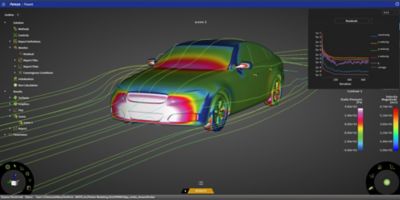
New Functionality for the Fluent Web Interface
The Fluent Web interface allows you to connect or launch your Fluent simulations on a web browser and start/stop/pause your simulations in real time. Updates in 2024 R2 include limited model set-up support, a template to connect to HPC, a multi-select context menu, and more.
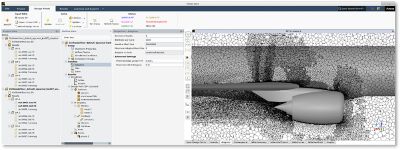
Advancements for Aerospace Use Cases
Updates to the Fluent Aero workspace (dedicated to external aerodynamics studies of aerospace applications) include compatibility with the virtual blade model (VBM) with the DBNS solver. Parametric post-processing is also now available to post-process numerous design points simultaneously. Automated PUMA mesh adaption is also now available.

Gas Turbines
Ansys gas turbine simulation solution enables you to design and optimize the next generation of gas turbines.


Mixing
Ansys fluid mixing simulation tools help you to model the mixing process and blending of one or more fluid-like materials.

Heat Exchangers
Ansys solutions optimize heat exchanger design with multiphysics modeling such as steady or transient conjugate heat transfer simulations. This critical and physics-based insight improves energy efficiency, materials selection, and lifetime performance prediction under harsh operating conditions.

Wind Turbines
Comprehensive wind turbine simulation, from embedded software to siting, predictive maintenance and digital twins.

Battery Simulation
Ansys battery modeling and simulation solutions use multiphysics to help you maximize battery performance and safety while reducing cost and testing time.

Rotating Machinery and Turbomachinery
Ansys solutions improve rotating machinery design, including fans, pumps, and compressors by increasing efficiency, safety, and durability. Ansys multiphysics simulation helps solve complex rotating machinery design challenges from turbine vibration to hydrogenator fluid flow.

Gas Liquid Systems
Learn how Ansys' multiphysics simulation enables you to efficiently scale up gas-liquid process equipment to maximize yield and improve efficiency.
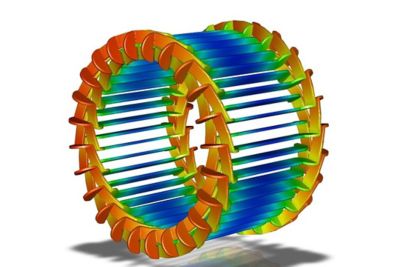
Electric Motors
Ansys electric motor design software progresses from concept design to detailed electromagnetics, thermal and mechanical analysis of electric motors.
Ansys Fluent is a general-purpose computational fluid dynamics (CFD) software used to model fluid flow, heat and mass transfer, chemical reactions, and more. Fluent offers a modern, user-friendly interface that streamlines the CFD process from pre- to post-processing within a single window workflow. Fluent is known for its advanced physics modeling capabilities, which include turbulence modeling, single and multiphase flows, combustion, battery modeling, fluid-structure interaction, and much more.
Also known for its efficient HPC scaling, large models can easily be solved in Fluent on multiple processors on either CPU or GPU. Multiple solver options are available, including pressure-based and density-based CPU solvers to cover low-speed to hypersonic flows and a pressure-based native GPU solver.
To install Ansys Fluent, first, you will have to download the Fluids package from the Download Center in the Ansys Customer Portal. Once the Fluids package is downloaded, you can follow the steps below.
- Open the Ansys Installation Launcher and select Install Ansys Products. Read and accept the clickwrap to continue.
- Click the right arrow button to accept the default values throughout the installation.
- Paste your hostname in the Hostname box on the Enter License Server Specification step and click Next.
- When selecting the products to install, check the Fluid Dynamics box and Ansys Geometry Interface box.
- Continue to click Next until the products are installed, and finally, click Exit to close the installer.
If you need more help downloading the License Manager or other Ansys products, please reference these videos from the Ansys How To Videos YouTube channel.
Installing Ansys License Manager on Windows
Installing Ansys 2022 Releases on Windows Platforms
Data can be exported after a Fluent calculation by selecting File - Export - Solution Data. Fluent allows users to export data to Mechanical APDL input, ASCII, ACS, CDAT, CGNS, CFF, EnSight Case Gold, and many other formats. To export data during a transient calculation, you will have to set up the case file so that the solution and particle history data are exported as the calculation progresses. This can be done by creating an automatic export definition using the Calculations Activities Task Page. Click the Create button under Automatic Export and select Solution Data Export, then select the file type, cell zones, surfaces, and quantities you would like to export.
Current customers can download Ansys Fluent from the Download Center in the Ansys Customer Portal. For those who are not current customers but are interested in trying Fluent, Ansys offers a free 30-day trial of Fluent upon request that comes with a CAD model and step-by-step pdf and mp4 tutorial. If you are a student, you can download our free student software and use it along with our free courses, support community, and a wealth of student-focused tutorials.
Ansys offers a variety of options for users of all skill levels to learn how to use Ansys Fluent. If you are interested in enhancing your simulation and general physics knowledge of fluids, Ansys offers Ansys Innovation Courses, which are free courses that will teach you the underlying physics in a problem and how Fluent is used to help solve this problem https://courses.ansys.com/index.php/fluids/
For introductory product-specific step-by-step tutorials, new feature videos, and general tips & tricks, we have the Ansys How to Videos on YouTube
Finally, the Ansys Learning Hub provides you with all the training resources needed to learn Ansys Fluent from the ground up. The Learning Hub has self-paced video courses, CAD models, best practice guides, demo videos, and learning rooms for questions and discussions to learn from the Ansys experts.
Ansys Fluent has two guided workflows to mesh a CAD model, the watertight geometry workflow and the fault-tolerant meshing workflow. Both workflows accelerate meshing by organizing the process into a user-friendly, task-based workflow that offers relevant choices and options but also has the flexibility to be customized. The watertight geometry workflow is for watertight CAD geometries that do not require much clean-up and modifications. The fault-tolerant meshing workflow is for more complicated non-water-tight CAD geometries that may require some clean-up and modifications (defects such as overlaps, intersections, holes, duplicates, etc.).
Mesh quality can be improved in a variety of places in Ansys Fluent. If you are still in the process of generating your mesh in Fluent Meshing mode, you can insert a task after both the 'Generate the Surface Mesh' task and 'Generate the Volume Mesh' task by right-clicking on either one and inserting a new 'Improve Mesh' task. To improve the surface mesh, you will have to enter a face quality limit to target, and when improving the volume mesh, you will have to enter a cell quality limit value to target. If you are in Fluent Solution mode, you can improve the mesh quality by selecting the improve the mesh option on the Quality button under the Domain tab. When selected, you will then enter the percentage of the total cells to be improved, and the number of iterations of smoothing sweeps performed.
Poor mesh quality can also be caused by insufficient mesh resolution of geometry details or by poor underlying CAD. Local mesh refinement controls can resolve geometry details appropriately, and poor CAD models can be improved in SpaceClaim/Discovery, or you can use Fluent's Fault Tolerant meshing workflow, which is robust to CAD faults.
Ansys Fluent unlocks new potentials for CFD analysis. A fluid simulation software with fast pre-processing and faster solve times to help you be the fastest to break into the market. Fluent’s industry leading features enable limitless innovation, while never making a compromise on accuracy.
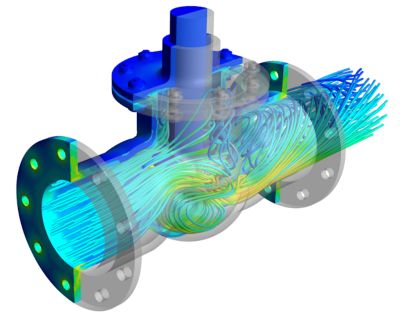
Explore the best fluid simulation tools on the market in an efficient, customizable workspace
- Streamlined Workflows
- Battery Modeling
- Electric Motor Cooling
- Turbulence Modeling
- Multiphase Flows
- Combustion Models
Accelerate your pre- and post-processing with streamlined workflows for meshing and application setups.
Fluent has customizable, task-based workflows for pre-processing to help accelerate the process of generating a high-quality CFD-ready mesh. These workflows are for both clean and dirty CAD. Application workflows are streamlined to help reduce the amount of clicks and panels a user has to deal with. These workflows include multiphase modeling, batteries, shape optimization, aerodynamics and more.
Advance your battery design and safety with rapid, accurate simulation. Electrochemistry can be used for age and life prediction. Battery thermal management and runaway can be simulated to ensure top performance and safety. A reduced order model (ROM) can be created by extracting key thermal characteristics to analyze temperature in seconds.
Electric motor cooling is critical as you move to higher power, high-efficiency equipment. Fluent can be used to find the appropriate cooling mechanism for an electric motor. Optimize this method, whether it's natural, water or spray cooled, to ensure motor efficiency is not impacted and magnets are not damaged.
A wide range of turbulence models are available to choose the right model for your application. Fluent offers a wide range of turbulence models including the industry-leading Generalized k-ω (GEKO) model. GEKO is a revolutionary concept with tunable coefficients that can be adjusted to different flow regimes.
Accurately simulate multiphase flows including gas-liquid, liquid-liquid, gas-solid, particle flows and even DEM. Different modeling approaches are needed as you move from single to multiphase flow applications, and Ansys understands this. To help accurately predict these challenging flows, we offer a wide range of models for gas, liquid, solid, particle flows and even DEM to get you the most accurate results.
Accurately predict interactions between fluids and solids from pressure and/or thermal loads. Solve your fluid-structure interaction challenge to make sure your product is safe, reliable and optimized. Fluent can solve FSI problems standalone and couples with Ansys Mechanical for the most complex simulations.
Accurate combustion models allow you to gain insight into system performance and flow phenomena.
Assuring you have accurate combustion is critical for the precise mix of turbulence, chemistry and the interaction between them. Fluent offers accurate and validated reacting flow models for your combustion applications_._
ANSYS FLUENT RESOURCES & EVENTS
Technical Paper

Best Practice: Scale-Resolving Simulations in Ansys CFD
This report is intended as an addition to the code-specific Theory and User Documentation available for both Ansys Fluent and Ansys CFX. That documentation describes in detail how to select and activate these models, so that information is not repeated here.
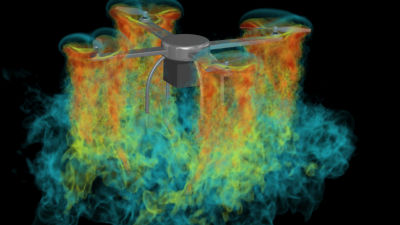
Ansys Video
Fluent: Watertight Geometry Meshing Workflow
Ansys Video
Ansys Fluent: Introduction to the GEKO Turbulence Model Part I
Ansys Video
Simulating Battery Pack Cooling System Using Ansys Fluent
Ansys Video
Ansys Cloud Demo with Fluent

